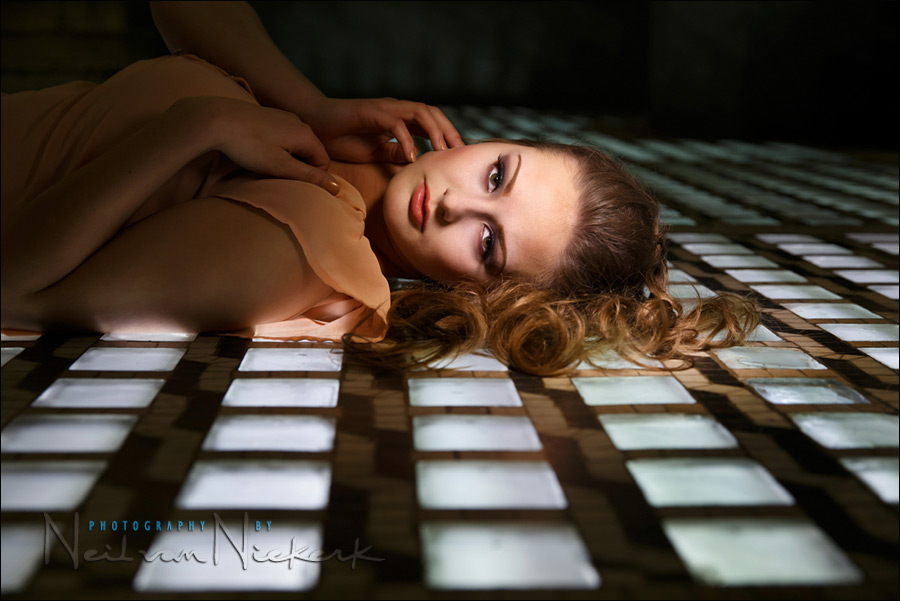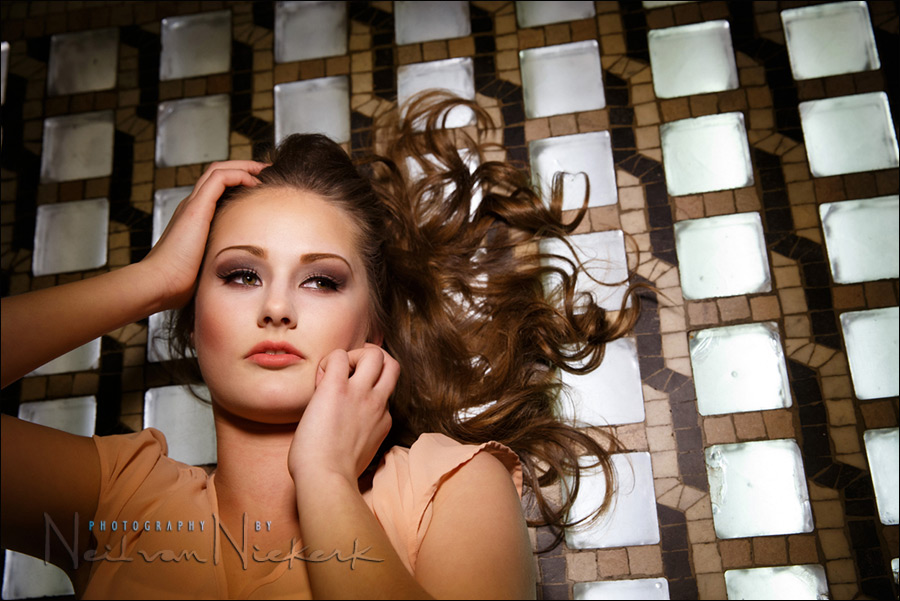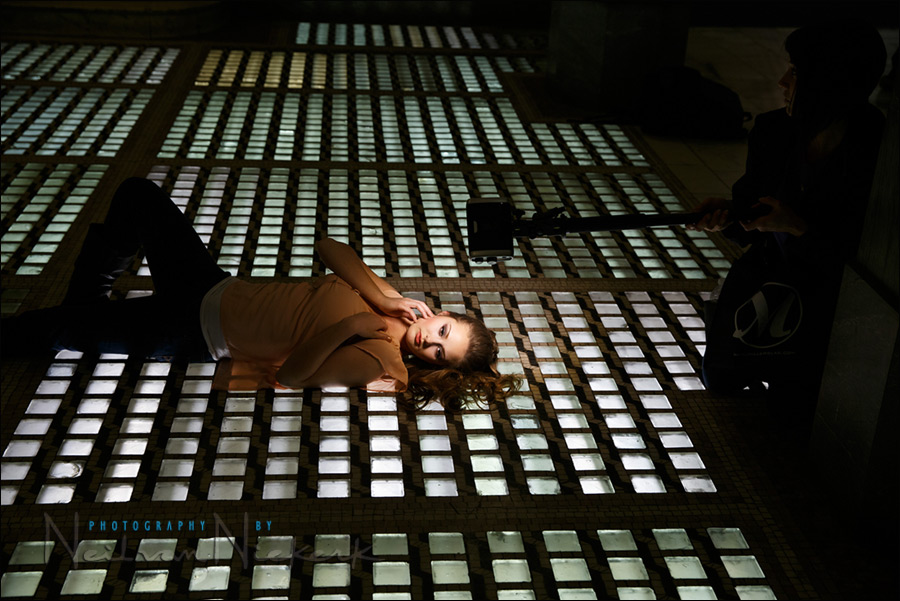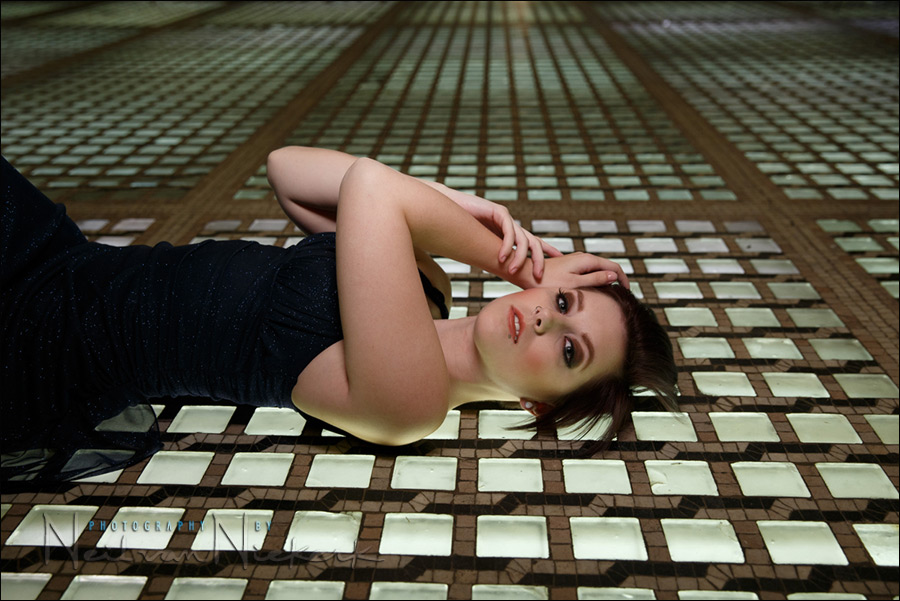
Flash with small softbox – vs – Video light
There are advantages to using a video light for photography, compared to using flash with a softbox or umbrella. The spread of light with a video light tend to be more contained, and hence more dramatic. However, if you use a small softbox with a speedlight, especially if it has a grid, you can get a similar tight spread of light.
With this session we had our model, Madison, laying down on this glass floor of the old Union Station. It is lit from underneath, creating these repetitive pools of light. Just beautiful.


Details & photo gear (or equivalents) used during this session
- model: Madison
- 1/80 @ f/4 @ 800 ISO
- Canon 6D
- Canon 24-70mm f/2.8L II
- recommended LED video light
I love this LED video light because it allows you to continuously change the color balance from Incandescent to Daylight. This is a really nice feature because you can now more closely match the additional light to the existing ambient light.
Compare the look of the light on her face in the photos above, with the light from a 10″ x 24″ strip box, as shown below.


Details & photo gear (or equivalents) used during this session
- model: Alyse
- 1/80 @ f/4 @ 800 ISO
- Canon 6D
- Canon 24-70mm f/2.8L II
- Canon 600EX-RT Speedlite (affiliate) / Canon ST-E3 Speedlite Transmitter (affiliate)
- Westcott Rapid Box Strip (10″ x 24″) (B&H / Amazon)
I used the same camera settings here as the image above – simply to have the same glow of light from the floor below her. Any change to a smaller aperture or lower ISO, would’ve darkened the lights below.
I really love video light for stills photography, and loved the images we got with Madison (shown at the top) while posing on this floor at the Union Station hotel. I then wanted to see if we could get a similar effect as the video light – with the light contained to a small area – by using a small softbox. I tried out this Westcott Rapid Box Strip 10″ x 24″ (affiliate), without a grid.
By scooping the light away from her, i.e., feathering the light upwards, and working very closely, we were able to get more dramatic light than a larger softbox would’ve given. So while it isn’t as dramatic as the video light, the light from the small softbox was soft, but contained to a small area. In other words, by feathering the light, instead of being pointed directly at our model, we have just the edge of light hit her, effectively creating a smaller light source.
To get the same kind of look as the video light, we would’ve had to use an even smaller softbox, and preferably with a grid. With that said, there is no wrong / right look here – it really is up to personal preference.
Related articles
- Using video lights for photography
- Buying a video light for Photography & Video
- After Dark Edu – St Louis, MO – April 2014
Hi Neil,
This video light looks definitely tempting, but I would have two questions :
-among all the other video lights you’ve tested out so far, would you consider this is a fair compromise at the moment for someone interested in buying it’s first video light equipement (of course as a complement to usual cobra flashes) withiout spending hundreds of dollars ?
-I’ve taken a look at Amazon and some other resellers’ sites and even on the brand site but couldn’t get the confirmation that it’s fully compatible with Nikon cameras, is it Neil !? You didn’t mention in your “Using video lights” which camera you used !
Thanks again for your beautiful photographs and for sharing tour knowledge and experience.
Hope you’re still doing well since Italy ! ;-)
Philippe
Hi there Philippe … because the video light is a continuous light source, there is no need to sync anything with the camera. Hence, it isn’t camera specific.
This is also why I don’t mention the camera make in that article you mentioned.
How do you rate the 6D, Neil? I added one of them to my stable of bodies about a month ago and I am very much impressed by it. Maybe not quite a 5DMKIII but the 6D really has some qualities that really make the camera shine. I am VERY impressed with the way it handles noise and high ISO, finding that even at 12,800 it yields images with marginally LESS noise than my 5DMKIII. Cheaper, a little more plasticky, sure, but it is a camera that delivers beautiful images and handles well – in my humble opinion.
My main system is Nikon, but for workshops I need to have Canon as well – so I went for the 6D as the lower-cost full-frame camera that would allow me all the options with their wireless flash system.
I love the camera – the image quality is superb.
What would concern me for professional use is the lack of dual memory cards.
Hey Neil,
I recently got a 6D for the incredible closeout price of $839 at Best Buy to use as a backup to the 5D IV, and to replace an aging 7D. How reliable or unreliable are you finding the outer single line sensitive AF points?
With the 6D, only the center AF point is the cross-type sensor. Therefore in lower light or with less contrast, the outer sensors will be slower to acquire focus. It will vary with scenario. Just confirm that the outer AF sensors are accurate. (As opposed to being fast to acquire focus.)
Great stuff as usual Neil. I am wondering if you have any experience with the Rotolights? The new Neo 2 sounds very interesting to me with the ability to serve as a continuous light and also a no recycle time flash. Is there a comparable light out there that you know of Neil? Just waiting on B&H now. Thanks. Jason
Jason … the Rotolights have piqued my interest, but I haven’t gotten my hands on one yet. I doubt though that it would be even nearly as powerful as a speedlight. In terms of size vs light output, nothing beats a speedlight.
What a gorgeous shot! Man! Her pose really complements the environment. Well done!!